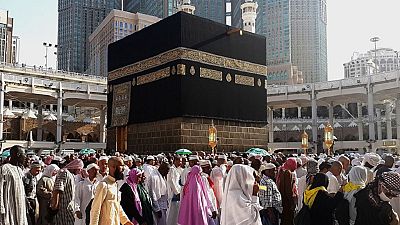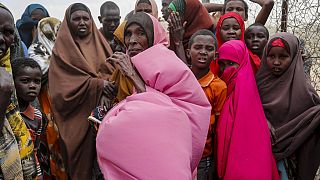Hajj
Millions of Muslims worldwide are heading to the Islamic holy city of Mecca in Saudi Arabia for this year’s Hajj pilgrimage.
The Saudi Arabia government has increased the quota of pilgrims from all the 178 registered countries with 950,000 pilgrims expected to arrive at Jeddah, 750,000 at Madinah and 100,000 by land and sea.
Last year, 1,325,372 foreign and 537,537 domestic pilgrims performed Hajj, making a total of 1,862,909 pilgrims – the least number recorded in the last 10 years.
The first group of pilgrims arrived in the city of Madinah last week from Pakistan to begin the religious rituals ahead of the largest annual gathering of people in the world starting on August 30 to September 4. 109 South African pilgrims were the first non-Arab Africans to arrive in the country last weekend for the pilgrimage.
At least 6,091 out of the 80,000 registered pilgrims have so far arrived in Saudi Arabia from Nigeria aboard 14 flights in four days, Nigerian officials said.
Ghana’s 6,200 pilgrims will begin their journey on August 10 by air from the capital Accra and northern city of Tamale.
9,300 pilgrims from Somalia are participating in Hajj this year as against the 7,300 pilgrims last year. The Somali government said that the Saudi government has also lifted the ban on allowing Somali livestock into the Kingdom.
Gambia is also sending 1,700 pilgrims this year while 15,000 from Ethiopia are participating. The island nation of Mauritius is sending 1,500 pilgrims from August 15.
29,000 medics and paramedics have been deployed by the Saudi health ministry to serve the Hajj pilgrims at its designated 25 hospitals and more than 155 temporal primary health care centers.
The facilities have 5,000 beds, including 500 for intensive-care units and 550 for emergencies with 100 mini-ambulances.
The ministry has instructed participating countries to administer a mandatory meningitis vaccination and a recommended flu vaccination for all pilgrims.
Travelers from countries at risk of yellow fever transmission must present a valid yellow fever vaccination certificate which is valid from 10 days after the vaccination date.
A polio vaccine is required from pilgrims of some 20 countries – 14 from Africa – that are deemed vulnerable to reinfection eventhough they are no longer affected by the disease.
The countries include: Cameroon, Central African Republic, Chad, Guinea, Laos, Madagascar, Myanmar, Niger, Ukraine, Democratic Republic of Congo, Equatorial Guinea, Ethiopia, Iraq, Kenya, Liberia, Sierra Leone, Somalia, South Sudan, Syria, and Yemen.
Hajj Ritual
The Hajj ritual is traced back to the time of the Prophet Abraham by Muslims. It is a religious obligation to embark on Hajj at least once in a lifetime of every Muslim who can afford it.
Hajj is observed for five days in the last month of the Islamic lunar calendar and is one of the five pillars of Islam.
Male pilgrims wear two white seamless cloths called Ihram which is meant to show equality before God.
One of the cloths is wrapped around the waist reaching below the knee and the other draped over the left shoulder and tied at the right side. For female pilgrims, they are allowed to wear any Islamically approved dresses when they reach the Miqat (a destination where intent is declared depending on where you are coming from).
The pilgrims perform ablution at the Miqat, declare their intention for Hajj and then refrain from all the prohibited activities including sexual relations, using perfumes, cutting nails, shaving, killing animals among others.
On the first day of Hajj, the pilgrims walk seven times around the Kaaba and kiss the black stone or point at it and pray if they can’t reach it.
This is followed by prayers inside the mosque near the Kaaba and then drink water from the Zamzam well which is believed to have gushed out where Abraham’s crying son Ishmael was placed when his mother went out looking for water for him.
The pilgrims then move to the Safa and Marwah hills near the Kaaba where they run or walk seven times between the hills like Ishmael’s mother Hagar did in search of water for her son.
The male pilgrims then completely shave their heads while the females cut a piece of their hair to signal the end of the ritual in Mecca called Umrah.
After the morning prayer, the pilgrims proceed to Mina where they spend the whole day in prayer.
They move to Arafat the next day and stand in vigil from noon to sunset to offer supplications, seek repentance and listen to sermons from where Prophet Muhammad is believed to have delivered his last sermon. The ritual at Arafat is compulsory to fulfil a Hajj successful.
The pilgrims leave Arafat for Muzdalifah where they combine two prayers and spend the night in the open and gather pebbles for the next day’s ritual.
They move to Mina to perform the symbolic stoning of the devil by throwing seven pebbles at the largest of three pillars.
Animals are slaughtered after throwing the pebbles to commemorate Abraham’s sacrifice to God. This is simultaneous with the Eid al-Adha festival of sacrifice celebrated by Muslims worldwide.
The male pilgrims shave their hairs after the sacrifice and females clips pieces of their hair. They then head to the holy mosque at Mecca for another circumambulation of the Kaaba.
On the fourth day, the pilgrims go to Mina and throw seven pebbles at each of the three pillars. The same ritual is done on the fifth day and the sixth if the pilgrim is not able to return to Mecca.
Before leaving Mecca, the pilgrims perform another circumambulation of the Kaaba for seven times anti-clockwise.
This ends the Hajj ritual.














02:03
Muhammadu Buhari's legacy: higlight of his presidential tenure
01:01
Kenya: Visa-free travel now available for many African and Caribbean countries
Go to video
Paraguayan town celebrates vibrant Kamba Ra'anga festival with masks, fire and tradition
00:55
Cristiano Ronaldo extends contract with Al-Nassr for 2 more years
01:47
Chinese city of Xuchang is world's biggest producer of wigs
01:15
U.S. considers adding more African countries to travel ban